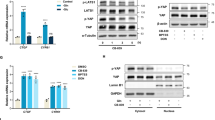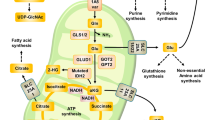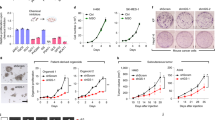Abstract
Cancer cells can use a variety of metabolic substrates to fulfill the bioenergetic and biosynthetic needs of their oncogenic program. Besides bioenergetics, cancer cell metabolism also directly influences genetic, epigenetic and signaling events associated with tumor progression. Many cancer cells are addicted to glutamine, and this addiction is observed in oxidative as well as in glycolytic cells. Although both oxidative and bioreductive glutamine metabolism can contribute to cancer progression and glutamine can further serve to generate peptides (including glutathione) and proteins, we report that glutamine promotes the proliferation of cancer cells independently of its use as a metabolic fuel or as a precursor of glutathione. Extracellular glutamine activates transcription factor signal transducer and activator of transcription 3 (STAT3), which is necessary and sufficient to mediate the proliferative effects of glutamine on glycolytic and oxidative cancer cells. Glutamine also activates transcription factors hypoxia-inducible factor-1, mammalian target of rapamycin and c-Myc, but these factors do not mediate the effects of glutamine on cancer cell proliferation. Our findings shed a new light on the anticancer effects of l-asparaginase that possesses glutaminase activity and converts glutamine into glutamate extracellularly. Conversely, cancer resistance to treatments that block glutamine metabolism could arise from glutamine-independent STAT3 reactivation.
This is a preview of subscription content, access via your institution
Access options
Subscribe to this journal
Receive 50 print issues and online access
$259.00 per year
only $5.18 per issue
Buy this article
- Purchase on Springer Link
- Instant access to full article PDF
Prices may be subject to local taxes which are calculated during checkout






Similar content being viewed by others
References
Pavlova NN, Thompson CB . The emerging hallmarks of cancer metabolism. Cell Metab 2016; 23: 27–47.
Patra KC, Hay N . The pentose phosphate pathway and cancer. Trends Biochem Sci 2014; 39: 347–354.
Possemato R, Marks KM, Shaul YD, Pacold ME, Kim D, Birsoy K et al. Functional genomics reveal that the serine synthesis pathway is essential in breast cancer. Nature 2011; 476: 346–350.
Payen VL, Brisson L, Dewhirst MW, Sonveaux P . Common responses of tumors and wounds to hypoxia. Cancer J 2015; 21: 75–87.
Ullah MS, Davies AJ, Halestrap AP . The plasma membrane lactate transporter MCT4, but not MCT1, is up-regulated by hypoxia through a HIF-1alpha-dependent mechanism. J Biol Chem 2006; 281: 9030–9037.
Dimmer KS, Friedrich B, Lang F, Deitmer JW, Broer S . The low-affinity monocarboxylate transporter MCT4 is adapted to the export of lactate in highly glycolytic cells. Biochem J 2000; 350 (Pt 1): 219–227.
Sonveaux P, Vegran F, Schroeder T, Wergin MC, Verrax J, Rabbani ZN et al. Targeting lactate-fueled respiration selectively kills hypoxic tumor cells in mice. J Clin Invest 2008; 118: 3930–3942.
Van Hée VF, Pérez-Escuredo J, Cacace A, Copetti T, Sonveaux P . Lactate does not activate NF-kB in oxidative tumor cells. Front Pharmacol 2015; 6: 228.
Hensley CT, Wasti AT, DeBerardinis RJ . Glutamine and cancer: cell biology, physiology, and clinical opportunities. J Clin Invest 2013; 123: 3678–3684.
Wise DR, DeBerardinis RJ, Mancuso A, Sayed N, Zhang XY, Pfeiffer HK et al. Myc regulates a transcriptional program that stimulates mitochondrial glutaminolysis and leads to glutamine addiction. Proc Natl Acad Sci USA 2008; 105: 18782–18787.
Mates JM, Segura JA, Martin-Rufian M, Campos-Sandoval JA, Alonso FJ, Marquez J . Glutaminase isoenzymes as key regulators in metabolic and oxidative stress against cancer. Curr Mol Med 2013; 13: 514–534.
Zaganas IV, Kanavouras K, Borompokas N, Arianoglou G, Dimovasili C, Latsoudis H et al. The odyssey of a young gene: structure-function studies in human glutamate dehydrogenases reveal evolutionary-acquired complex allosteric regulation mechanisms. Neurochem Res 2014; 39: 471–486.
Yang C, Sudderth J, Dang T, Bachoo RM, McDonald JG, DeBerardinis RJ . Glioblastoma cells require glutamate dehydrogenase to survive impairments of glucose metabolism or Akt signaling. Cancer Res 2009; 69: 7986–7993.
Reitzer LJ, Wice BM, Kennell D . Evidence that glutamine, not sugar, is the major energy source for cultured HeLa cells. J Biol Chem 1979; 254: 2669–2676.
Metallo CM, Gameiro PA, Bell EL, Mattaini KR, Yang J, Hiller K et al. Reductive glutamine metabolism by IDH1 mediates lipogenesis under hypoxia. Nature 2012; 481: 380–384.
Li F, Xu W, Zhao S . Regulatory roles of metabolites in cell signaling networks. J Genet Genomics 2013; 40: 367–374.
Chandra V, Hong KM . Effects of deranged metabolism on epigenetic changes in cancer. Arch Pharm Res 2015; 38: 321–337.
Bellance N, Lestienne P, Rossignol R . Mitochondria: from bioenergetics to the metabolic regulation of carcinogenesis. Front Biosci (Landmark Ed) 2009; 14: 4015–4034.
Prickett TD, Samuels Y . Molecular pathways: dysregulated glutamatergic signaling pathways in cancer. Clin Cancer Res 2012; 18: 4240–4246.
Roland CL, Arumugam T, Deng D, Liu SH, Philip B, Gomez S et al. Cell surface lactate receptor GPR81 is crucial for cancer cell survival. Cancer Res 2014; 74: 5301–5310.
Thorne JL, Campbell MJ . Nuclear receptors and the Warburg effect in cancer. Int J Cancer 2015; 137: 1519–1527.
Lincet H, Icard P . How do glycolytic enzymes favour cancer cell proliferation by nonmetabolic functions? Oncogene 2015; 34: 3751–3759.
Wise DR, Thompson CB . Glutamine addiction: a new therapeutic target in cancer. Trends Biochem Sci 2010; 35: 427–433.
De Saedeleer CJ, Copetti T, Porporato PE, Verrax J, Feron O, Sonveaux P . Lactate activates HIF-1 in oxidative but not in Warburg-phenotype human tumor cells. PLoS One 2012; 7: e46571.
De Saedeleer CJ, Porporato PE, Copetti T, Pérez-Escuredo J, Payen VL, Brisson L et al. Glucose deprivation increases monocarboxylate transporter 1 (MCT1) expression and MCT1-dependent tumor cell migration. Oncogene 2014; 33: 4060–4068.
De Preter G, Neveu MA, Danhier P, Brisson L, Payen VL, Porporato PE et al. Inhibition of the pentose phosphate pathway by dichloroacetate unravels a missing link between aerobic glycolysis and cancer cell proliferation. Oncotarget 2016; 7: 2910–2920.
Ratnikov B, Aza-Blanc P, Ronai ZA, Smith JW, Osterman AL et al. Glutamate and asparagine cataplerosis underlie glutamine addiction in melanoma. Oncotarget 2015; 6: 7379–7389.
Shanware NP, Bray K, Eng CH, Wang F, Follettie M, Myers J et al. Glutamine deprivation stimulates mTOR-JNK-dependent chemokine secretion. Nat Commun 2014; 5: 4900.
Bergstrom J, Furst P, Noree LO, Vinnars E . Intracellular free amino acid concentration in human muscle tissue. J Appl Physiol 1974; 36: 693–697.
Hakimi J, Bosmann HB . The intrinsic glutaminase activity of asparaginase: cytotoxicity and cellular resistance. Res Commun Chem Pathol Pharmacol 1979; 26: 581–595.
Avramis VI, Tiwari PN . Asparaginase (native ASNase or pegylated ASNase) in the treatment of acute lymphoblastic leukemia. Int J Nanomedicine 2006; 1: 241–254.
Guillaumond F, Leca J, Olivares O, Lavaut MN, Vidal N, Berthezene P et al. Strengthened glycolysis under hypoxia supports tumor symbiosis and hexosamine biosynthesis in pancreatic adenocarcinoma. Proc Natl Acad Sci USA 2013; 110: 3919–3924.
Vander Heiden MG, Cantley LC, Thompson CB . Understanding the Warburg effect: the metabolic requirements of cell proliferation. Science 2009; 324: 1029–1033.
Semenza GL . HIF-1: upstream and downstream of cancer metabolism. Curr Opin Genet Dev 2010; 20: 51–56.
Metzen E, Wolff M, Fandrey J, Jelkmann W . Pericellular PO2 and O2 consumption in monolayer cell cultures. Respir Physiol 1995; 100: 101–106.
Hou P, Kuo CY, Cheng CT, Liou JP, Ann DK, Chen Q . Intermediary metabolite precursor dimethyl-2-ketoglutarate stabilizes hypoxia-inducible factor-1alpha by inhibiting prolyl-4-hydroxylase PHD2. PLoS One 2014; 9: e113865.
Nicklin P, Bergman P, Zhang B, Triantafellow E, Wang H, Nyfeler B et al. Bidirectional transport of amino acids regulates mTOR and autophagy. Cell 2009; 136: 521–534.
Yokogami K, Wakisaka S, Avruch J, Reeves SA . Serine phosphorylation and maximal activation of STAT3 during CNTF signaling is mediated by the rapamycin target mTOR. Curr Biol 2000; 10: 47–50.
Chresta CM, Davies BR, Hickson I, Harding T, Cosulich S, Critchlow SE et al. AZD8055 is a potent, selective, and orally bioavailable ATP-competitive mammalian target of rapamycin kinase inhibitor with in vitro and in vivo antitumor activity. Cancer Res 2010; 70: 288–298.
Schust J, Sperl B, Hollis A, Mayer TU, Berg T . Stattic: a small-molecule inhibitor of STAT3 activation and dimerization. Chem Biol 2006; 13: 1235–1242.
Zhong Z, Wen Z, Darnell JE Jr . Stat3: a STAT family member activated by tyrosine phosphorylation in response to epidermal growth factor and interleukin-6. Science 1994; 264: 95–98.
Yu H, Lee H, Herrmann A, Buettner R, Jove R . Revisiting STAT3 signalling in cancer: new and unexpected biological functions. Nat Rev Cancer 2014; 14: 736–746.
Commisso C, Davidson SM, Soydaner-Azeloglu RG, Parker SJ, Kamphorst JJ, Hackett S et al. Macropinocytosis of protein is an amino acid supply route in Ras-transformed cells. Nature 2013; 497: 633–637.
Tardito S, Oudin A, Ahmed SU, Fack F, Keunen O, Zheng L et al. Glutamine synthetase activity fuels nucleotide biosynthesis and supports growth of glutamine-restricted glioblastoma. Nat Cell Biol 2015; 17: 1556–1568.
Jin L, Li D, Alesi GN, Fan J, Kang HB, Lu Z et al. Glutamate dehydrogenase 1 signals through antioxidant glutathione peroxidase 1 to regulate redox homeostasis and tumor growth. Cancer Cell 2015; 27: 257–270.
Yang L, Moss T, Mangala LS, Marini J, Zhao H, Wahlig S et al. Metabolic shifts toward glutamine regulate tumor growth, invasion and bioenergetics in ovarian cancer. Mol Syst Biol 2014; 10: 728.
Jewell JL, Kim YC, Russell RC, Yu FX, Park HW, Plouffe SW et al. Metabolism. Differential regulation of mTORC1 by leucine and glutamine. Science 2015; 347: 194–198.
Siveen KS, Sikka S, Surana R, Dai X, Zhang J, Kumar AP et al. Targeting the STAT3 signaling pathway in cancer: role of synthetic and natural inhibitors. Biochim Biophys Acta 2014; 1845: 136–154.
Banda M, Speyer CL, Semma SN, Osuala KO, Kounalakis N, Torres Torres KE et al. Metabotropic glutamate receptor-1 contributes to progression in triple negative breast cancer. PLoS One 2014; 9: e81126.
Yaguchi T, Saito M, Yasuda Y, Kanno T, Nakano T, Nishizaki T . Higher concentrations of extracellular ATP suppress proliferation of Caco-2 human colonic cancer cells via an unknown receptor involving PKC inhibition. Cell Physiol Biochem 2010; 26: 125–134.
Kumarevel T, Nakano N, Ponnuraj K, Gopinath SC, Sakamoto K, Shinkai A et al. Crystal structure of glutamine receptor protein from Sulfolobus tokodaii strain 7 in complex with its effector L-glutamine: implications of effector binding in molecular association and DNA binding. Nucleic Acids Res 2008; 36: 4808–4820.
Xu Q, Briggs J, Park S, Niu G, Kortylewski M, Zhang S et al. Targeting Stat3 blocks both HIF-1 and VEGF expression induced by multiple oncogenic growth signaling pathways. Oncogene 2005; 24: 5552–5560.
Pawlus MR, Wang L, Hu CJ . STAT3 and HIF1alpha cooperatively activate HIF1 target genes in MDA-MB-231 and RCC4 cells. Oncogene 2014; 33: 1670–1679.
Niu G, Briggs J, Deng J, Ma Y, Lee H, Kortylewski M et al. Signal transducer and activator of transcription 3 is required for hypoxia-inducible factor-1alpha RNA expression in both tumor cells and tumor-associated myeloid cells. Mol Cancer Res 2008; 6: 1099–1105.
Poli V, Camporeale A . STAT3-mediated metabolic reprograming in cellular transformation and implications for drug resistance. Front Oncol 2015; 5: 121.
Hassanein M, Hoeksema MD, Shiota M, Qian J, Harris BK, Chen H et al. SLC1A5 mediates glutamine transport required for lung cancer cell growth and survival. Clin Cancer Res 2013; 19: 560–570.
Robinson MM, McBryant SJ, Tsukamoto T, Rojas C, Ferraris DV, Hamilton SK et al. Novel mechanism of inhibition of rat kidney-type glutaminase by bis-2-(5-phenylacetamido-1,2,4-thiadiazol-2-yl)ethyl sulfide (BPTES). Biochem J 2007; 406: 407–414.
Parmentier JH, Maggi M, Tarasco E, Scotti C, Avramis VI, Mittelman SD . Glutaminase activity determines cytotoxicity of L-asparaginases on most leukemia cell lines. Leuk Res 2015; 39: 757–762.
Munoz J, Dhillon N, Janku F, Watowich SS, Hong DS . STAT3 inhibitors: finding a home in lymphoma and leukemia. Oncologist 2014; 19: 536–544.
Catlett-Falcone R, Landowski TH, Oshiro MM, Turkson J, Levitzki A, Savino R et al. Constitutive activation of Stat3 signaling confers resistance to apoptosis in human U266 myeloma cells. Immunity 1999; 10: 105–115.
Groner B . Determinants of the extent and duration of STAT3 signaling. JAKSTAT 2012; 1: 211–215.
Decker T, Kovarik P . Serine phosphorylation of STATs. Oncogene 2000; 19: 2628–2637.
Gough DJ, Koetz L, Levy DE . The MEK-ERK pathway is necessary for serine phosphorylation of mitochondrial STAT3 and Ras-mediated transformation. PLoS One 2013; 8: e83395.
Corbet C, Draoui N, Polet F, Pinto A, Drozak X, Riant O et al. The SIRT1/HIF2alpha axis drives reductive glutamine metabolism under chronic acidosis and alters tumor response to therapy. Cancer Res 2014; 74: 5507–5519.
Acknowledgements
This work was supported by a Starting Grant from the European Research Council (ERC no. 243188 TUMETABO), Interuniversity Attraction Pole (IAP) grant #UP7-03 from the Belgian Science Policy Office (Belspo), an Action de Recherche Concertée from the Communauté Française de Belgique (ARC 14/19-058), the Belgian Fonds National de la Recherche Scientifique (FRS-FNRS), the Télévie and the Belgian Fondation contre le Cancer (2012-186). PS is a FRS-FNRS Research Associate. AC is a Postdoctoral Fellow and MS a Research Fellow of the Télévie. We thank Marylène Focant from Promega (Leiden, The Netherlands) for having provided glutamine/glutamate-Glo Assay kits.
Author information
Authors and Affiliations
Corresponding author
Ethics declarations
Competing interests
The authors declare no conflict of interest.
Additional information
Supplementary Information accompanies this paper on the Oncogene website
Supplementary information
Rights and permissions
About this article
Cite this article
Cacace, A., Sboarina, M., Vazeille, T. et al. Glutamine activates STAT3 to control cancer cell proliferation independently of glutamine metabolism. Oncogene 36, 2074–2084 (2017). https://doi.org/10.1038/onc.2016.364
Received:
Revised:
Accepted:
Published:
Issue Date:
DOI: https://doi.org/10.1038/onc.2016.364
This article is cited by
-
STAT proteins in cancer: orchestration of metabolism
Nature Reviews Cancer (2023)
-
Glutaminase (GLS1) gene expression in primary breast cancer
Breast Cancer (2023)
-
Glutamine deficiency promotes stemness and chemoresistance in tumor cells through DRP1-induced mitochondrial fragmentation
Cellular and Molecular Life Sciences (2021)
-
A novel tumor suppressor CECR2 down regulation links glutamine metabolism contributes tumor growth in laryngeal squamous cell carcinoma
Clinical and Translational Oncology (2021)
-
Amino Acid Transporters and Exchangers from the SLC1A Family: Structure, Mechanism and Roles in Physiology and Cancer
Neurochemical Research (2020)



